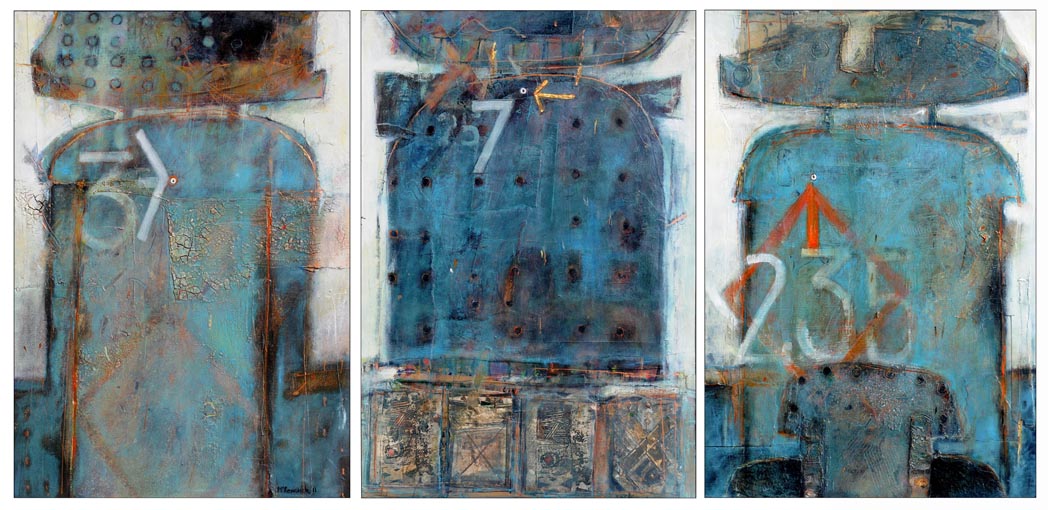 The triptych ‘Datum Marks on Blue’ by Glasgow based artist Tom McKendrick RSW RGI, who has taught and painted in parallel over the last thirty years, features on the cover the 2012 Annual Exhibition catalogue and Watermark, the free RSW newsletter. Here is an insight into his work.
The triptych ‘Datum Marks on Blue’ by Glasgow based artist Tom McKendrick RSW RGI, who has taught and painted in parallel over the last thirty years, features on the cover the 2012 Annual Exhibition catalogue and Watermark, the free RSW newsletter. Here is an insight into his work.
Can you tell me about your own development as an artist – did anything in your childhood influence you, when and why did you start painting?
In common with most artists, creativity began in early childhood. The wonderful Miss McDonald, my primary three teacher arrived at school one day with a huge bag of pastels, a ream of multi coloured paper and a hand full of postcards. A rare event in the fifties. I copied a trawler crashing through heavy seas, I have no doubt that the rendering was probably primitive, but the work was hung in the staff room and the magic stuck.
How would you describe your technique?
Technique is such an interesting area. There are some artworks that rely on technique alone and are to be greatly admired for their mastery. They however may or may not be great works of art. Herein lies a contradiction …mastering a technique does not make you an artist but to be an artist it is to your advantage to be a technical master. Technically I like to push things almost to destruction for instance by sandpapering works with fine emery or scorching or scrubbing…
You use a diverse range of materials, often working multi-media, what are the special qualities that watercolour can bring to your work?
Essentially I am a watercolour painter… a medium which provokes in the mind of many, delicate techniques on fine paper to encourage luminosity and transparency. Modern pigments and water based mediums have been extensively developed over the past 30 years meaning the medium can be pushed to extremes…it is in the extremes that I am most comfortable. Transparency is critical regardless; this gives the work body and depth. I may have over thirty transparent layers on a painting.
Do you have a preferred subject and why?
‘Surfaces’ are important, Texture is important. A surface that has been exposed to change tells the story of its existence. All things are transient, I like to capture things past their best…as they decay and disintegrate. That is when they are at their most interesting.
Which artists do you think have had an influence on your work?
If you were to ask for influences I would present an endless list of names. There are so many to choose from, all masters in their chosen fields.
You have had several major solo exhibitions – Blitz, Submarine, Rivet Temple, Iron and Heavier Than Air – are you currently working on a new exhibition? If not, what are you doing next?
In September 2012 I have retrospective/new work exhibition in Glasgow Art Club. It will be interesting to see aspects of a lives work and development side by side. What is the inspiration behind Datum Marks on Blue, the triptych on the cover of this year’s exhibition catalogue?
I worked as a Loftsman for 6 years in John Browns Shipyard. A Loftsman’s job was to draw and mark the components of a ship in full scale, make templates from drawings and transfer these to steel and the building process. Datum Marks were the essence of this work, designating for example where a deck began, seams ended, machinery was placed, curves delineated and marking and identifying thousands of components. Arrows, numbers, lines and punch marks were methods used to do this work. ‘Datum Marks on Blue’ is an assemblage of these components on corroded and painted surface.
You have two prints – Rivet Marker and Blue Rivet Panel – for sale in the RSW Online Gallery – please can you tell us about these paintings?
The rivet is a simple yet fascinating component. The world’s largest man made structures are held together with these little bands of steel. There is on Clydeside a great mythology associated with the riveting process, almost religious. Watching a rivet being formed by a pneumatic hammer is beautiful, it transforms from white hot steel, through to red, darkening to a deep cherry, into purple blue then steely blue as it cools, formed and binding it scars the surface that surrounds it with a perfect soft dark pastel ring. All this beauty is conducted with skill and powerful forces in a hell of noise…the contradictions a vital component. Both paintings are objects awaiting this process.
